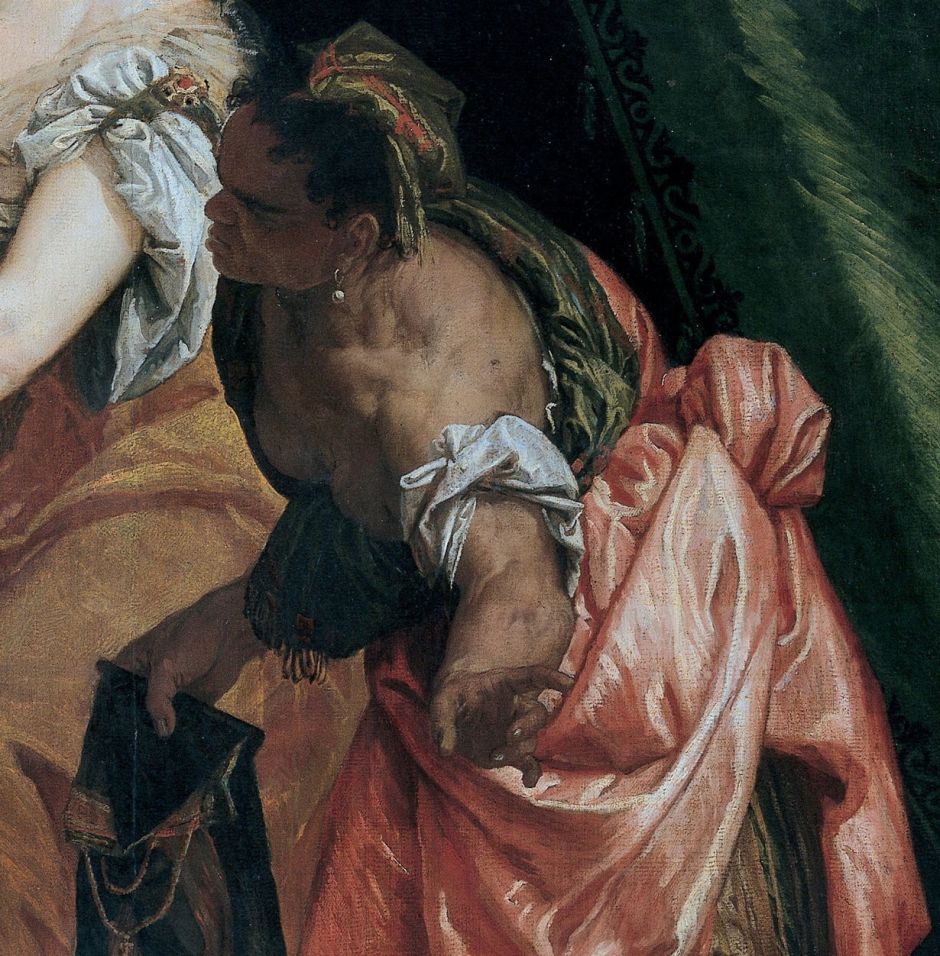In the first article in this series, I attempted a brief outline history of visible brushstrokes in paintings between 1400 and 1700. This read – in terms of artists – Jan van Eyck (a little in vegetation), El Greco, Peter Paul Rubens (oil studies), and the late Rembrandt.
Those who know their Italian Masters will surely have been wondering about my omission of several of the great Venetian painters. Although I was aware that some had quite painterly styles, it was not until I stumbled across a copy of Philip Sohm’s book Pittoresco that I had sufficient information to produce this summary.
It is Sohm’s contention that the term painterly (Wölfflin’s malerisch, Italian pittoresco) was redefined by Marco Boschini in his book Carta del navegar pitoresco (1660), and applied to styles of painting seen most commonly in Venetian painters, and a few others including Parmigianino and Dosso Dossi. Most prominent in these styles are visible brushstrokes. These are part of a contrast between Florentine, linear painting with the emphasis on disegno (drawing, design), and Venetian, painterly painting with the emphasis on colorito (colouring, painting).
Although Sohm produces many more examples from a long list of artists, I will illustrate just seven paintings from four artists, including El Greco (who was mentioned in the first article, but not illustrated).
Titian (c 1490–1576)
When Titian, perhaps the most famous of all the Venetian Masters, was older, his style became quite overtly painterly, with significant passages in many of his works having clearly visible brushstrokes.

The Death of Actaeon (c 1559-75) is a good example of this painterly style, with many of the looser passages being obvious even at this scale.

Closer examination shows painterly rough brushwork in the brights of the water surface, fabrics, vegetation, and distant objects. In each case, this practice results in distinctive texture, as compared, for example, with the smooth skin, and the coats of the dogs.

The Rape of Europa (1560-2) is another painting which does not attempt to hide its painterly facture.

The most obvious gestural marks once again appear in fabrics, the water surface and objects beneath it (such as the large fish at the bottom).
Jacopo Bassano (c 1510–92)

Although most of Bassano’s paintings appear finished to Florentine standards, and at first sight his The Way to Calvary (c 1544-5) appears no exception, some are delightfully painterly when examined more closely.

What appear from a distance to be meticulously-detailed fabrics turn out to be rich in marks left by the brush. These are most abundant in the coarse petticoat seen billowing in the lower right, and in the sheen on the satin of the woman’s left arm, as well as the white sheet which she holds up.
Paolo Veronese (1528–88)
Many of the later works of Veronese are rich in visible brushstrokes. I offer just two examples: it is worth studying high-resolution images and the originals of his paintings after about 1570 to discover more very painterly passages.

From a distance, the tight composition of his Allegory of Love, IV, ‘The Happy Union’ (c 1575) looks to have been painted in disegno, although differences in fabric textures and the splash of light cloud suggest that more detailed examination is needed.

Once closer to the canvas, many of the details turn out to be painterly caresses with the brush, in the fabrics and hair in particular.

Later still, Veronese’s Judith and Holofernes (c 1580) make no attempt to conceal the scumbled highlights of its fabrics.

A detail shows how extensive and free Veronese was in making his marks, although they are largely confined to fabrics, with flesh being painted more smoothly.
El Greco (1541–1614)
El Greco was Greek in origin – his real name was Doménikos Theotokópoulos (Δομήνικος Θεοτοκόπουλος) – but was born on the island of Crete when it was a Venetian colony. He trained in post-Byzantine art there, and travelled to Venice in about 1567. In 1570 he moved to Rome, and did not settle in Toledo, Spain, until 1577, when he was 36. Thus his tendency towards colorito rather than disegno may be the result of his Venetian training.

El Greco’s Annunciation (1614) is obviously rich in visible brushstrokes, particularly in its fabrics, and the heavenly host above.

More detailed examination of those figures in the heavens shows them to be very sketchy, with an abundance of marks.

Another of his late works, The Vision of Saint John (1608-14) is quite unlike anything being painted by others at the time, and bears obvious marks in several passages, particularly those depicting fabrics.

This detail shows the rich brushstrokes in fabrics, and in the sky.
Conclusions
From my previous list of types of mark-making, those seen in Venetian and other Masters appear to be mainly textural marks, with some becoming more gestural, particularly in El Greco, where a few may have become more formative.
It is tempting to speculate that Francesco Guardi‘s very painterly works from the late eighteenth century were following in this Venetian tradition, although as they only appeared in his later views and capriccios, this begs the question as to why he – like Titian, Veronese, and Rembrandt – did not leave them in his earlier paintings.
Sohm also reveals how extensive was the discussion among critics about painterly style, and how those artists who used it were accused of leaving their works ‘unfinished’ long before the same debates and accusations were made of the Impressionists. Perhaps we should view Impressionism more as a development of Venetian colorito rather than something radically new?
Reference:
Sohm PL (1991) Pittoresco: Marco Boschini, his Critics, and their Critiques of Painterly Brushwork in Seventeenth- and Eighteenth-Century Italy, Cambridge UP. ISBN 978 0 5213 8256 4.

